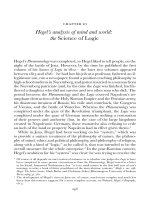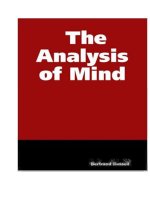CURRICULUM AND INSTRUCTION: THE TEACHING OF ENGLISH pot
Bạn đang xem bản rút gọn của tài liệu. Xem và tải ngay bản đầy đủ của tài liệu tại đây (1.05 MB, 142 trang )
MODULE 6.
1
CURRICULUM AND INSTRUCTION:
THE TEACHING OF ENGLISH
Teacher Induction Progra
m
Teacher Education Council, Department of Education
Ofelia Oracion Flojo, M.A.T.
Writer
Bernadette S. Pablo, M. Ed.
Reviewer/ Editor
All rights reserved. This module may not be reproduced in any
form without the permission of the Teacher Education Council,
Department of Education.
TEACHER INDUCTION PROGRAM
MODULE 6.1
Curriculum and Instruction:
The Teaching of English
Welcome. You are now part of the DepEd family. As a novice teacher, you
must be eager to try out what you have learned as you immerse yourself in the task of
educating the future citizens of the land.
Your primary concern as a beginning teacher is to be able to teach English
effectively using developmentally appropriate classroom practices. This module will
help you understand certain issues affecting language and language learning and
reflect on them. As you go through this module, you sharpen your self-awareness as a
teacher and gain confidence that will enable you to make classroom decisions that will
most benefit the learners.
Brief Description of the Module
Lesson I focuses on teaching listening what listening is, why we do listening,
and what the different types of listening are. It also provides sample activities for
listening comprehension.
Lesson 2 deals with the nature of the oral communication process, the barriers
to effective communication, and suggestions to improve one’s speaking ability.
Lesson 3 focuses on teaching reading which anchors on the five areas of
reading instruction, namely; phonemic awareness, phonics and decoding, vocabulary
and word recognition, fluency, and comprehension. Each of these elements, together
with the development of higher order thinking skills, is vital if children are to become
successful, thinking, and literate adults. Varied strategies are provided that illustrate
effective classroom practices to enable students to read for meaning. It also stresses
the role of reading in the content areas. The sample lesson plans show how these
strategies work to foster active and engaged reading.
Lesson 4 deals with the teaching of writing and how it can be made more
interesting and meaningful to students. It discusses the nature of writing and
specifically explains the writing process. It includes varied activities that will surely
encourage children to generate ideas and organize them into writing. It also gives
suggestions for marking written compositions.
Lesson 5 focuses on assessment, both traditional and authentic. It provides
sample assessment and evaluation instruments for classroom use. Sample tests are
provided to serve as models in constructing language tests.
i
OBJECTIVES
This module presents a systematic program of study intended for teachers of
English in the BEC. It maintains a consistent link between theory and practice by
providing learning activities to illustrate and test theoretical ideas. As you go through
the different lessons, you will be able to analyze how the different theories of
language are translated into practice.
At the end of this module, you are expected to:
1. Reflect on the different aspects of communication and acquire skills for
effective English instruction;
2. Adopt practical strategies that will enhance the students’ skills in listening,
speaking, reading, writing, and literature;
3. Discuss learners’ problems and needs and come up with developmentally
appropriate strategies to help them achieve success; and
4. Use alternative processes in assessment and evaluation.
At the start of the module, you are to take the preassessment test to see how
much background information and knowledge you have in teaching English.
This module is self-instructional. You can read, analyze concepts and ideas
presented, and reflect on them. The Activities and Self-Check Questions will help you
assess how you progress as you go through the module. If you need help and further
clarification, you can ask the assistance of a mentor or facilitator in your school. It has
been recommended that as much as possible, the mentor is one of your peers or
colleagues. He or she may also be your department head or principal.
Your answers to the Self – Check Questions (SCQ’s) and Activities may be
self-evaluated by your mentor or facilitator if you so desire. These will be part of your
formative evaluation. DO NOT WRITE YOUR ANSWERS IN THE MODULE. YOUR
ANSWERS SHOULD BE WRITTEN IN A SEPARTE NOTEBOOK.
ii
The Answer Key to the SCQ’s and Activities are found at the end of this
module. The post assessment will be given in a separate booklet upon completion of
the module. It will serve as the summative evaluation of your performance.
Remember, you are to work on this module independently. I shall not be
around to supervise you as you go through each lesson. It is expected that you will
make the most of this module and grow professionally in your desire to become a
competent teacher of English, determined to make a difference.
iii
TABLE OF CONTENTS
Page
Introduction i
Objectives ii
Preassessment 1
Lesson 1 Teaching Listening 8
Why Listen 10
The Listening Process 11
How People Listen 13
Choosing the listening texts 15
Integrating Listening with Other Macro Skills 16
Lesson 2 Teaching Speaking 22
The Nature of the Oral Communication Process 24
Barriers to Effective Communication 25
Successful Oral Fluency Practice 27
Oral Communication Strategies 30
Lesson 3 Teaching Reading 35
Five Areas of Reading Instruction 37
Phonemic Awareness 37
Phonics and Decoding 39
Vocabulary Instruction 40
Fluency 40
Comprehension 42
Profile of a Proficient Reader 43
Three Stages of Teaching Reading Instruction 44
Prereading Strategies 45
Activating Prior Knowledge and Building
Background Information 45
iv
Developing Concept and Vocabulary 49
Developing and Motivation Purpose 52
During Reading Strategies 53
Post-Reading Strategies 58
Discussion 58
Engagement Activities 62
Reading-Writing Link 67
Reading Intervention and Remediation 68
Building Literacy: A Classroom Intervention Program 71
Lesson 4 Teaching Writing 76
Principles of Teaching Writing 77
The Process-Oriented Approach to Writing 78
Pre-writing stage 78
Techniques in Prewriting 79
Writing 81
Techniques for Composing and Drafting Paragraphs 81
Revising and Proofreading 82
Techniques for Revising and Proofreading 83
Post Writing 84
Marking Written Composition 89
Lesson 5 Assessment 93
Purposes of Assessment 95
Forms of Assessments 96
Traditional Assessment 96
Non-traditional or Authentic Assessment 96
Some Beliefs that Support the Use of Authentic Assessment 97
Learning Targets 99
v
vi
Types of Learning Targets 99
Authentic Assessment Practices to Try 100
Traditional Testing Compared to Performance Assessment 103
Scoring and Recording Assessment 104
Answer Key to Preassessment, SCQ’s and Activities 108
Bibliography 119
Appendices 121
A Lesson Plan in Content Area Reading 121
Sample Cloze Passage 124
YOPP-SINGER TEST OF PHONEME SEGMENTATION 125
SUMMARY OF READING AND WRITING DEVELOPMENT 126
Reading-Response Log 127
Paper - and - Pencil Test 130
TEACHER INDUCTION PROGRAM PREASSESSMENT
PREASSESSMENT PREASSESSMENT
A. True or False A. True or False
Directions: Read the sentences carefully. Write TrueDirections: Read the sentences carefully. Write True, if the sentence is correct
and False, if it is incorrect.
__________1. Background knowledge plays a significant role in text
comprehension, thus, it should be discussed and shared.
__________2. Appropriateness in language use means knowing what to say
about something, how to say it, to whom, where, and when to say
it.
__________3. Performance tasks should assess only the specific skills taught.
__________4. Checklists and anecdotal records document students’ progress;
hence, they should be graded.
__________5. Assessment is done to determine the ratings to be given students
in the different subjects.
__________6. The ability to speak fluently cannot be taught directly; rather, it
“emerges” independently in time.
__________7. Conversation is the central focus of language and the keystone of
language acquisition.
__________8. Revising is a postwriting procedure which involves editing and
proofreading.
__________9. A common strategy in responding to literature is making
predictions.
__________10. Every individual exhibits multiple intelligences even though some
of them may be out of awareness or underdeveloped.
__________11. One example of a listening activity is a pronunciation drill on
minimal pairs.
__________12. The crux of listening is getting the message and interpreting it.
__________13. When one listens to instructions he or she needs to note the
specifics and execute them as directed.
MODULE 6.1: CURRICULUM AND INSTRUCTION (ENGLISH)
1
TEACHER INDUCTION PROGRAM PREASSESSMENT
__________14. As a listener, you seldom quote the exact words of the speaker
unless you find a word, phrase, or statement in what was said
worth quoting.
__________15. In a conversational exchange, there is a shifting of roles of
listener and speaker, usually in short turns of a few seconds.
__________16. Critical or analytical listening is called for when viewing TV ads,
listening to political speeches or debates, and in problem-solving
situations.
__________17. When listening in real life, there are certain noise “bits” of the
discourse that are unintelligible to the hearer which he or she
cannot ignore.
__________18. After establishing the context and activating the background
knowledge in the pre-listening phase, the teacher explains the
listening task so that the students know what is expected of
them.
__________19. Students are told beforehand what to pay attention to in a
listening text, then they employ selective listening as the text is
presented to them.
__________20. In an informal conversation, it is unnatural for the speaker to
repeat words, paraphrase, or correct himself at some points.
B. Multiple Choice:
Directions: Choose the word or phrase that will best complete each of the
following statements. Write the letter of your answer.
1. The sender and receiver of the message is one and the same person in
_____________________.
a. an interpersonal communication.
b. an intrapersonal communication.
c. a public communication.
d. an interview.
MODULE 6.1: CURRICULUM AND INSTRUCTION (ENGLISH)
2
TEACHER INDUCTION PROGRAM PREASSESSMENT
2. One of the language-related reasons that are cited for failure to communicate
effectively is __________________.
a. the way the message is delivered.
b. the situation or setting.
c. the loose and haphazard organization of ideas in extended talk.
d. the way the person feels.
3. Live interactions where most individuals are audience rather than sources
occur in ____________________.
a. intrapersonal communication.
b. public communication.
c. interpersonal communication.
d. informal communication.
4. One strategy wherein students are asked to say aloud their thoughts as they
react to the selection line-by-line or sentence by sentence is
___________________.
a. read aloud.
b. say aloud.
c. compose aloud.
d. think aloud.
5. In a conversation, turn-taking involves the following skills EXCEPT
_________________.
a. being able to use one’s turn properly.
b. knowing how to signal that one wants to speak.
c. knowing the right moment to get a turn without appearing rude.
d. introducing oneself as he/she opens a conversation.
6. An effective way of promoting communication in the classroom is by getting
students involved in ___________.
a. discussion activities.
b. reading.
c. answering questions.
d. monitoring.
MODULE 6.1: CURRICULUM AND INSTRUCTION (ENGLISH)
3
TEACHER INDUCTION PROGRAM PREASSESSMENT
7. An example of informal English is the expression ___________________.
a. It was nice of you to come.
b. Pardon me.
c. Good morning, Miss Angeles.
d. Thanks for coming.
8. In a conversation, we observe turn-taking conventions by
____________________.
a. giving the correct answers.
b. recognizing other people’s signals of their desire to speak.
c. changing the topic of discussion.
d. getting the attention of the other person.
9. The most common form of one-way communication is
____________________.
a. speech.
b. milling around.
c. Interview.
d. role playing.
10. One type of oral interpretation concerned with narrating a story or tale by
reading or by narrating it from memory is____________________.
a. chamber theater.
b. choral speaking.
c. storytelling.
d. dramatization.
11. The foundation for early literacy development is ____________________.
a. storytelling.
b. oral language.
c. alphabet knowledge.
d. phonemic awareness.
12. A holistic, literature-based approach in teaching beginning reading is
____________________.
a. Language Experience Approach
b. Directed Reading Thinking Activity
c. Four-Pronged Approach
d. Direct Reading Instruction
MODULE 6.1: CURRICULUM AND INSTRUCTION (ENGLISH)
4
TEACHER INDUCTION PROGRAM PREASSESSMENT
13. Knowledge of the alphabetic principle refers to the ___________________
a. understanding that spoken words are made up of individual phonemes.
b. knowledge that enables a child to correctly recognize and pronounce
familiar, irregular words.
c. knowledge that the letter is the basic unit of reading and writing.
d. understanding that spoken words are made up of phonemes and that
those phonemes are represented in text as letters.
14. One of the main goals of prereading activities is _____________________
a. asking questions.
b. setting the purpose for reading.
c. enrichment instruction.
d. scaffolding.
15. Concept mapping is a strategy used in _______________
a. reading aloud.
b. guided reading.
c. vocabulary development.
d. recreatory reading.
16. All of these factors except one (1) influence children's motivation to read.
Which one does not help children develop a desire to read?
a. self-choice
b. personal interests
c. knowledge gained
d. choice by teachers or parents
17. A benefit of conducting read-aloud is __________________________
a. building background knowledge and experience.
b. reflecting the emotions, tone, and style of the text.
c. developing children’s understanding of the patterns and structures of
written language.
d. focusing on all the students in the classroom.
18. Going beyond the literature after reading enables students to elaborate on
the selection by ______________________________________________
a. actively integrating new information with existing knowledge.
b. being participative and creative.
c. starting the discussion with the motive question.
MODULE 6.1: CURRICULUM AND INSTRUCTION (ENGLISH)
5
TEACHER INDUCTION PROGRAM PREASSESSMENT
d. writing a response journal.
19. GPU or Gradual Psychological Unfolding is a discussion technique based
on the _______________________.
a. Audio-lingual Method
b. Question and Answer Relationship (QAR)
c. Socratic Method
d. Direct Method
20. Critical thinking enables the reader to _____________________________
a. recall explicit details in the text.
b. discover the purpose of the author for writing the selection.
c. integrate the author’s ideas with the reader’s own ideas.
d. follow the events as they happened in the story.
21. Writing has a variety of forms which depends on _____________________
a. drawing connections between bits of experiences.
b. the purpose for the writing.
c. communication of ideas and feelings.
d. the mode or medium of expression.
22. During this stage, the teacher helps children discover what they already
know about the topic and encourages them to question, select, and order
information from a variety of sources.
a. prewriting
b. composing and drafting
c. editing
d. publishing
23. The best approach to teach reading and writing is____________________.
a. direct instruction
b. natural approach
c. independent practice
d. a combination of approaches
24. Writing is a craft that can be learned and its skills developed through
____________________
a. reading about writing.
b. beautiful penmanship.
c. informed practice.
MODULE 6.1: CURRICULUM AND INSTRUCTION (ENGLISH)
6
TEACHER INDUCTION PROGRAM PREASSESSMENT
MODULE 6.1: CURRICULUM AND INSTRUCTION (ENGLISH)
7
d. correct grammar.
25. Success at writing encourages ___________________
a. further writing.
b. organizing thoughts.
c. presenting ideas.
d. practice in oral language.
26. The writing process is _______________
a. linear
b. recursive and creative.
c. sequential and evaluative.
d. hierarchical.
27. A test in order to be valid should be _______________
a. reliable.
b. practical.
c. objective.
d. global.
28. A test that measures the extent of learning in a prescribed domain is
______________
a. an aptitude test.
b. a proficiency test.
c. an achievement test.
d. a diagnostic test.
29. ______________ are used to collect samples of student work overtime to
track student development.
a. Rubrics
b. Portfolios
c. Reading logs
d. Anecdotal records
30. The teacher guides students through the pre-writing stage which includes all
these activities except______________
a. brainstorming.
b. discussion.
c. proofreading.
d. outlining.
TEACHER INDUCTION PROGRAM LESSON 1: TEACHING LISTENING
LESSON
1
TEACHING
LISTENING
INTRODUCTION
Did you know that _________________________
your fastest means of communication is listening?
you get more than 40 percent of your information through listening?
you receive messages from any direction, from around corners, and
through some barriers?
Listening is a familiar part of our everyday experience. Actually, most people
spend a large part of their waking hours listening, with varying degrees of attention,
to language and other stimuli.
However, despite the importance of listening it is not given the attention it
deserves in the classroom. Students are not trained to listen attentively and critically
since it is assumed that listening skills will just develop as a matter of course. But
that is contrary to research findings. Due to inability to listen proficiently,
communication breakdown in oral interaction occurs. Because many fail to listen
critically, miscommunication leads to other serious problems.
It is, therefore, important that listening skills be taught to prepare students for
effective functioning outside the classroom.
MODULE 6.1: CURRICULUM AND INSRUCTION (ENGLISH)
8
TEACHER INDUCTION PROGRAM LESSON 1: TEACHING LISTENING
OBJECTIVES
At the end of this lesson, you should be able to: At the end of this lesson, you should be able to:
explain the listening process; explain the listening process;
give reasons for doing listening; give reasons for doing listening;
differentiate the types of listening; differentiate the types of listening;
prepare varied listening activities for listening comprehension. prepare varied listening activities for listening comprehension.
ACTIVITY 1.1
1. Here are some classroom activities. Decide which are listening activities and
which are not.
a. Learners respond orally to a written exercise.
b. Learners complete a task while listening to a taped conversation.
c. The teacher explains some special arrangement for the following week’s
lesson.
d. A learner asks the teacher a question about the meaning of a word.
e. The teacher conducts a drill with the class.
f. A learner formulates a sentence silently before uttering it.
g. Two learners carry out a pair work activity.
h. The teacher tells a story.
i. The teacher converses with the class before the lesson starts.
j. The class is engaged in a pronunciation exercise focusing on two
contrasting sounds.
MODULE 6.1: CURRICULUM AND INSRUCTION (ENGLISH)
9
TEACHER INDUCTION PROGRAM LESSON 1: TEACHING LISTENING
READ
Listening is attending to what you consider important. It is trying to get the
meaning of what you hear. To listen successfully to spoken language, you need to be
able to work out what speakers mean when they use particular words in particular
ways in particular situations. The important thing about listening is getting the
message and interpreting it.
Why listen?
There are five main reasons why people listen.
1. To be able to engage in social rituals - As a social being man usually engages
in social rituals such as exchanging pleasantries, engaging in small talk,
attending meetings, and the like.
2. To get information - In school, students have to listen attentively to get
important ideas from a lecture or from class discussions.
3. To be able to respond to “controls”–There is need for attentive listening to be
able to follow directions and instructions given orally.
4. To respond to feelings – It is necessary to listen with empathy to understand
what a person means and how he or she feels. This occurs when one listens
to complaints or secrets.
5. To enjoy – Listening enables us to share a good laugh with others as when
we exchange jokes. It could also serve as a source of pleasure when we
listen to music and oral interpretations of literary pieces.
MODULE 6.1: CURRICULUM AND INSRUCTION (ENGLISH)
10
TEACHER INDUCTION PROGRAM LESSON 1: TEACHING LISTENING
SCQ 1.1
How well did you remember what you read? Answer the following questions
briefly.
1. What is listening?
2. Give at least three reasons for listening. Give examples.
(Check your answers against ASCQ 1.1.)
The Listening Process
There are five steps in the listening process (Devito, 1997) as illustrated in the
figure that follows.
2. Understanding
Making sense of what
was said
Deciphering
1. RECEIVING
Hearing
Attending
3. REMEMBERING
Recalling
Retaining
5. RESPONDING
Answering
Giving Feedback
4. EVALUATING
Judging worth
Critical review of what
was said
The Listening Process
Figure 1
MODULE 6.1: CURRICULUM AND INSRUCTION (ENGLISH)
11
TEACHER INDUCTION PROGRAM LESSON 1: TEACHING LISTENING
1. Receiving the speaker’s message. Messages, both verbal and non-verbal,
consist of words as well as gestures, facial expressions, and variation in volume
and tone. The listener takes note of both the verbal and non - verbal elements of
the message.
2. Determining what the speaker means. Understanding takes into consideration the
thoughts that are expressed as well as the emotional tone that accompanies
these thoughts. It likewise includes establishing links between what the listener
knows about the topic and the new information from the speaker.
3. Retaining messages for at least some period of time. The listener actually
remembers not what was said, but what she or he thinks, as recalled, was said.
A listener seldom quotes the exact words of the speaker unless he or she finds a
word, phrase, or something worth quoting.
4. Evaluating or weighing what was said. The listener judges the worth of the ideas
shared by the speaker. He or She assesses them in the light of what he or she
knows about the topic taking into account the logic of the presentation.
5. Sending signals to let the speaker know that he is understood and responding to
him after he has stopped talking. This marks the start of a new cycle where the
listener takes his turn as a speaker.
SCQ 1.2
Rearrange in correct sequence these steps in the listening process.
__ Evaluating what was said based on what the listener knows about the topic.
__ Receiving the message sent by the speaker.
__ Responding to the speaker the moment he stopped talking.
__ Understanding what the speaker means.
__ Recalling what the listener thinks was said by the speaker.
MODULE 6.1: CURRICULUM AND INSRUCTION (ENGLISH)
12
TEACHER INDUCTION PROGRAM LESSON 1: TEACHING LISTENING
READ
How People Listen
Listening can be classified into several types depending on how you pay
attention to what is being said or heard.
Marginal/passive listening–Also called hearing or auding, the listener
hears the sounds, often in the background but simply ignores them.
Because he or she is engrossed in another task.
Attentive listening–The listener focuses attention and shows interest in
what is being said. He or she takes note of the specifics and how they
relate to the main points made by the speaker.
Critical/analytical listening–In this type of listening one has to decide on
the truth of ideas, pass judgment on claims made and make decisions on
whether to accept what she or he hears, reject it or take it with a grain of
salt.
Appreciative listening–This type of listening gives the listener pleasure
maybe from the humor, or the blending of voices in choric arrangements.
MODULE 6.1: CURRICULUM AND INSRUCTION (ENGLISH)
13
TEACHER INDUCTION PROGRAM LESSON 1: TEACHING LISTENING
SCQ 1.3
What follows is a checklist of listening activities. Identify each by checking under the
appropriate column.
Type of Listening
Marginal Attentive
Critical Appreciative
Listening
Listening
Listening Listening
1. Paying attention selectively and
constantly varying the level of
attention while engaged in other
tasks simultaneously.
2.
Making judgments about which
content to select for remembering.
3.
Interpreting implied information,
attitude and intention.
4.
Predicting, comparing what’s heard
with what was predicted, and revising
predictions.
5.
Filtering out any other ambient
language or other sounds, but
remaining prepared to filter them in
again as and when necessary.
6.
Getting the gist of a talk.
7. Enjoying the music played over the
radio without understanding the
words.
8. Performing actions in response to
instruction given orally.
9. Identifying a general topic or
information given in a listening text.
10.
Interpreting music through dance.
11.
Rewriting the listening text in
different works: either in the same
language (paraphrase) or in another
(translation).
12.
Discussing a problem that is
described orally and writing down a
suggested solution.
MODULE 6.1: CURRICULUM AND INSRUCTION (ENGLISH)
14
TEACHER INDUCTION PROGRAM LESSON 1: TEACHING LISTENING
ACTIVITY 1.2
Make a list of as many situations you can think of where people are listening
to other people. These include situations where they may be doing other things
besides listening–speaking but the essential point is that they need to be able to
understand what is said in order to function satisfactorily in the situation.
(Now compare your list with that given in Checkpoint 1.2)
Choosing the Listening Texts
It is best to select authentic texts, that is, materials that students are expected
to meet and listen to in real life. You can record excerpts of the following texts or
read them aloud at normal speed: advertisements, newscasts, weather reports,
announcements, homilies, doctor–patient consultations, job interviews, etc. Here are
some questions you may consider in choosing listening texts. Make students enter
the answers in the grid that follows:
1. What type of talk is it?
2. Where do you expect to hear it?
3. Who is talking and to whom is he talking?
4. What is the objective of the speaker?
5. What type of listening is called for in the situation?
MODULE 6.1: CURRICULUM AND INSRUCTION (ENGLISH)
15
TEACHER INDUCTION PROGRAM LESSON 1: TEACHING LISTENING
Types of Talk Where
it may
be
heard
Speaker Person(s)
addressed
Objectives
of the talk
Types of
listening
called for
1.
2.
3.
4.
5.
Integrating Listening with Other Macro Skills
Most listening activities are not limited to listening. They are often integrated
with the other macro-language skills, namely speaking, reading and writing. In this
listening activity entitled “Taking Note of House Rules”, the students listen to a taped
dialog, but they are asked to picture study (reading), mark with an X the infringement
of the rules (writing) and draw the same scene without the infringements of those
rules. Note that the task in the Pre-listening phase, if done orally would entail
speaking skills.
Taking Note of House Rules
MODULE 6.1: CURRICULUM AND INSRUCTION (ENGLISH)
16









